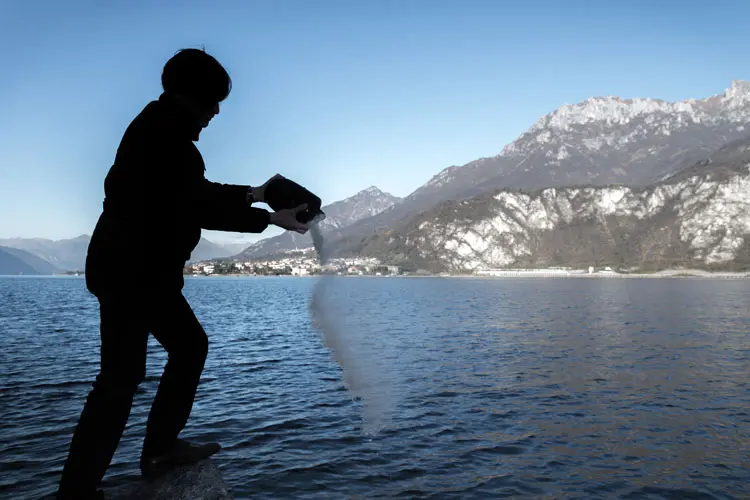Do You Need Permission to Scatter Ashes on a Beach?
After a loved one’s life is lost, the family members are left with the option of a burial or cremation. Sometimes, many families may pick direct cremation for several reasons as discussed in this article. However, if the human remains eventually become cremated remains, scattering ashes becomes the next consideration to discuss.
What happens when your loved one’s ashes are to be spread at the sea? Are there particular rules guiding scattering cremains? These are just a few ideas on the questions to consider before you scatter cremated remains.
There are many more specific regulations to explore, as we shall discuss below. Read on for a breakdown of scattering urns or scattering ashes at sea.

What Do the UK Rules and Regulations Say with Regards to Scattering Ashes?
You can scatter the ashes of a deceased loved one anywhere in the United Kingdom. As ashes easily decompose, there are no specific rules and regulations guiding their disposal from the environmental agency.
As long as you have the consent of the landowner in terms of private property, you are good to go. Ashes of a deceased loved one can be scattered on a homeowner’s lawn or public property without the stress. It can go as far as being used to create a garden feature without the requirement for a special permit.
It’s not necessary to get permission to spread ashes at sea or across a river. However, doing so in accordance with the Environment Agency’s recommendations will help ensure the safety of the marine environment.
Do You Need a Permit for Scattering Ashes?
The rules and regulations regulating scattering ashes can vary greatly from state to state, therefore you may require a permit for scattering at the beach. In California, for instance, filing an application and permission with the county is required prior to any ash scattering. This is why, before scattering ashes, you should research the rules in your state and fill out the necessary documentation.
A separate permission for the event itself may be needed if you want to have many people present, as in a ceremony or other formal gathering. You may need documents like the death certificate or approvals from a mortuary board.
Even if you don’t require a special permit, there are a few things to keep in mind while scattering ashes. You should think about the other people who want to enjoy the beach and try to go when it’s not as busy. There may be rules in effect that prohibit ash from spreading on beaches that are part of a state or national park.
Before you embark on any sort of adventure in most national parks, make sure you have the all-clear from the ranger. Be wary about scattering the ashes too close to other persons since the ashes might be blown in their direction.
Where Can You Scatter Your Loved One’s Ashes?
When it comes to the places where you can scatter ashes, your options are literally unlimited. However, there are a few options that you may consider pretty brilliant. There may also be due processes you may like to take for the sake of courtesy. Below are some of these options for a scattering ceremony:
Scatter Ashes on A Private Property
Creating a new flower bed or garden feature out of a loved one’s ashes is a popular way to memorialize their passing. You can also plant a tree or a flower garden there to memorialize the departed in a way that brings you comfort. All these options are explorable within your private property.
No authorization from anybody else is required if you own the property. Be aware, though, that if you ever decide to relocate, you might not be able to return to the site.
Parks, meadows, and country walks are all examples of private land, therefore it’s important to get permission from the owner before you visit. Even while the property owner will be glad to have your ashes dispersed on their property, always be polite and nice as you take their permission.
Scatter Ashes in the Cemetry
The ashes of your loved one might be scattered over the grave of their spouse if they are both buried in the same cemetery. Including this in a will is a frequent way to express your intentions for your funeral, and it’s also a popular option among British families.
If you have exclusive ownership of the burial plot, you are free to spread the remains there whenever you choose. However, you should get in touch with the cemetery owner first if your use rights have lapsed.
Scattering Ashes at Sea or Beaches
When it comes to scattering ashes, one of the most considered options is the sea or beach. The seaside is an attractive option for scattering ashes when the conditions are favorable. The ashes can be scattered into the air, or you can dig a shallow trench in the sand and let the waves carry them away to the ocean floor.
You should contact the beach in advance, but most of them in the UK will allow families to scatter ashes on the sand or rocks. If you look up the beach on the internet, you can generally find a phone number for it as well. You should also pick a calm period and not a windy day so that those who are swimming or tanning aren’t inconvenienced by the ashes. It will also be in your favor if you plan a sea ceremony.
Scattering Ashes at the Moutain or Hillside
The mountains and hillsides are quiet and natural; it’s just the perfect scene for a rest. Ashes are traditionally scattered from a mountaintop, or cliff’s edge, where they can be carried swiftly away by the wind. It seems to reason that places of natural beauty, such as mountains and hills is what most families choose.
Scattering ashes on a mountain or steep slope requires you to do it at a relatively low altitude. This will not only benefit the delicate plants near the summit, but it will also make it simpler for your loved ones to visit the location in the future. If you plan on sprinkling the ashes somewhere private, you should probably get permission beforehand.
Spreading Ashes at Other Special Locations
An individual’s ashes may be scattered in the stadium where they cheered for their favorite team all their life. At memorial events hosted by certain clubs, mourners are welcome to spread a loved one’s ashes straight on the field. If you have any questions regarding this, you may contact the club at the number provided on their website.
That’s not all; why not try national parks, amusement parks, golf courses, uninhabited public land, or even Disney World? There is no federal law limiting how the immediate family can carry out the scattering process. Focus on making your loved one happy.
How to Scatter Cremated Remains or Ashes at the Beach or Sea
The act of spreading ashes at sea may be a touching and meaningful way to honor their memory. To assist you to get going, follow the whole process below:
Research the Regulations in Your Area about Dispersing Ash
Scattering cremains is governed by a different set of local and state laws in each of the 50 states. This is a crucial step since different states have guiding federal regulations regarding the scattering of ashes.
For example, Florida and California have distinct paperwork that must be filled out before spreading ashes on a beach. It is vital to familiarize yourself with your state laws, the legal requirements of the park, and any other regulatory information.
Also, check the urn you should use for the process of holding cremated remains. It’s best to use biodegradable urns for your scattering urn. Biodegradable urns are much more environmentally friendly and widely acceptable.
Pick a Spot at the Sea
Choose a meaningful place for you and your loved one to scatter the ashes. You may choose to scatter their cremains at the sea if that’s where they spent a lot of happy memories. If you’re stuck for ideas, try researching local beaches with landmarks or interesting characteristics.
Preparing the Ashes
Ashes need to be ready once a venue has been selected. Large quantities of ashes may necessitate water urns, a biodegradable urn, or another temporary container. Otherwise, any tiny box or bag made of velvet would do. If you plan on bringing cremains with you to the beach, make careful to securely seal the container.
Choose Your Process
The family may find it more comforting to scatter ashes by tossing them softly at the water’s edge rather than going out into the water. This way, it will gradually wash into the water.
Some people may want to travel further out into the inland waters in order to spread the ashes there. This way, you can believe the ashes will sink into the coral reefs.
Whatever you decide to do is entirely up to you and your loved ones; there is no “correct” response. The ashes can be scattered from a boat if you wish to travel nautical miles into the water.
Hold a Ceremony as You Wish
You may choose sea burials after deciding how and where to spread the ashes. It just takes a few words, a poem, a call for participation, or a quiet moment. Find something that has personal significance and fits the mood of the event if you can.
Having such an event will cost you more but will give the moment more significance. There’s no state law imposing tax dollars on such events. Also, you can save costs by reducing extras like flower petals.
Scatter the Cremains
There is no longer any reason to keep the ashes buried. If you’re wondering, “How can I disperse the cremains?” Do not feel embarrassed; this is a difficult section for everyone. Your hands, a scoop, a shovel, an ash dispersal tube, a box, a sack, or the urn itself can all be used to scatter the ashes. You have the option of scattering the cremains in the air, in the sand to be swept away by the tide, over the sea as you wade out into the ocean, or a combination of these.
Before diving in, assess the water’s depth and the velocity of the current. If you choose to keep the urn with the cremains in it, be sure neither is lost or stolen.
Scattering cremated remains at sea may be an emotionally healing and spiritually uplifting experience for family and friends left behind. Be respectful of other beachgoers and adhere to any federal clean water act that may be in place.
If you want to make sure the ash dispersion you are planning goes off without a hitch, creating a memorial website to educate people about it is a good idea. A memorial website will make it easy to inform people about death, post an obituary, collect memories, and raise money for a cause.
Can You Cremate Pet Remains?
Beyond cremating the bodies of people close to us, it is actually possible to cremate pet remains as well. When an animal is cremated, its body is put in a tiny container and subjected to extreme heat. Your pet can be cremated in a matter of hours with temperatures reaching up to 2000 degrees Fahrenheit.
The outcome will be shards of bone and ash. All metal surgical implants, such as plates and screws, will be clearly visible at this time and can be returned to you if desired. Afterward, the pet cremains is crushed into thin gray ash and then carefully deposited in a plastic bag or warm blanket.
Many crematoriums feature memorial lawns where the ashes of the deceased can be scattered in a dignified manner. If you like, you can preserve the pet ashes in an urn, bury them, or scatter them.
Conclusion
It’s community service when scattering ashes is properly done. A health agency will advise you not only to consider your processes but the overall environment. With the processes in this post, scattering the ashes of your loved ones shouldn’t be a problem. For any more assistance, you can reach out to us.


